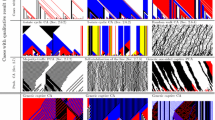Abstract
We investigate the dynamics of ensembles of diffusive defects in one-dimensional deterministic cellular automata. The work builds on earlier results on individual random walks in cellular automata. Here we give a natural condition guaranteeing diffusive behavior also in the presence of other defects. Simple branching and birth mechanisms are introduced and prototype classes of cellular automata exhibiting weakly interacting walks capable of annihilation and coalescence are studied. Their equilibrium behavior is also characterized. The design principles of cellular automata with desired diffusive interaction properties become transparent from this analysis.
Similar content being viewed by others
References
R. Arratia, Limiting point processes for rescalings of coalescing and annihilating random walks onZ d,Ann. Prob. 9(6):900–936 (1981).
N. Boccara, J. Nasser, and M. Roger,Phys. Rev. A 44(2):866 (1991).
M. Bramson and J. Lebowitz, Asymptotic behavior of densities for two-particle annihilating random walks,J. Stat. Phys. 62:297–372 (1992), and references therein.
K. Eloranta, The interaction dynamics of the kinks in the cellular automaton Rule 18, Helsinki University of Technology, Institute of Mathematics, Research Report A 306 (1991).
K. Eloranta, Partially permutive cellular automata,Nonlinearity 6(6):1009–1023 (1993).
K. Eloranta, Random walks in cellular automata,Nonlinearity 6(6):1024–1036 (1993).
K. Eloranta and E. Nummelin, The kink of the elementary cellular automaton Rule 18 performs a random walk.J. Stat. Phys. 69(5/6):1131–1136 (1992).
R. Fernández, J. Fröhlich, and A. Sokal,Random Walks, Critical Phenomena, and Triviality in Quantum Field Theory (Springer, Berlin, 1992).
P. Grassberger, New mechanism for deterministic diffusion,Phys. Rev. A.,28:3666–3667 (1983); Chaos and diffusion in deterministic cellular automata,Physica D 10:52–58 (1984).
D. Griffeath,Additive and Cancellative Interacting Particle Systems (Springer, Berlin, 1979).
B. Kitchens and K. Schmidt, Markov subgroups of (Z/2Z)Z2,Contemp. Math. 135:265–283 (1992).
F. Ledrappier, Un champ Markovien peut être d'entropie nulle et mélangeant,C. R. Acad. Sc. Paris A 287:561–562 (1978).
D. A. Lind, Applications of ergodic theory and sofic systems to cellular automata,Physica D 10:36–44 (1984).
K. Petersen,Ergodic Theory (Cambridge University Press, Cambridge, 1983).
V. Privman, Model of cluster growth and phase separation: Exact results in one dimension,J. Stat. Phys. 69(3/4) (1992).
M. A. Shereshevsky, Ergodic properties of certain surjective cellular automata, preprint University of Warwick (1991).
Author information
Authors and Affiliations
Rights and permissions
About this article
Cite this article
Eloranta, K. The dynamics of defect ensembles in one-dimensional cellular automata. J Stat Phys 76, 1377–1398 (1994). https://doi.org/10.1007/BF02187067
Received:
Accepted:
Issue Date:
DOI: https://doi.org/10.1007/BF02187067




